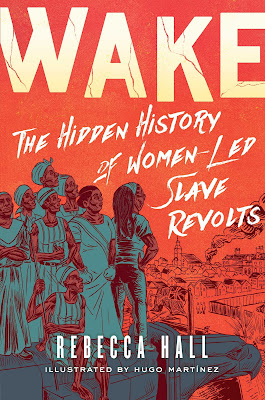On a recent Pop Culture Happy Hour, PCHH guest Joelle Monique recommended Wake: The Hidden History of Women-Led Slave Revolts by Rebecca Hall and illustrated Hugo Martinez on one of their regular What's Making Me Happy segments.
I tend to shy away from books about slavery because I feel like the tendency is to get a bit inured to the pain in each of the stories, as they all sort of blend into one. So I pick and choose carefully what to read and I was so impressed when I was reading and came across this that echoed those feelings so carefully.
 |
| Chapter 7, page 15 |
This book is a mishmash of genres because on one hand, it's the tale of women's participation in slave revolts, an untapped story. On the other hand, it's also the story of the author's work process and research methods, so Hall herself is a character in the story. It's filled with beautiful illustrations from Martinez, including this amazing two-page spread of past and current New York City separated by water.
 |
| Chapter 2, pages 10-11 |
There's just so much in this book. From stories of women who are tried for their role in slave revolts, but there's no documentation of what happened to them to stories of how enslaved women were placed on the deck with no irons (!) which is why slave revolts happened more frequently on ships with larger percentages of women to stories of how Hall herself was repeatedly kicked out of locations while trying to do research.
Things of Note:
Barracoon - The name for the cage/barracks that held enslaved people as they waited for transportation across the Atlantic.
John Locke - Influential philosopher, whose thoughts were integral to the development of the philosophy that underpins the U.S. Constitution. Investor in one of the British Empire's largest organizations that profited because of slavery, the Royal Africa Company. Hall writes "a luminary of the Enlightenment and perhaps the central theorist of American democracy" (Chapter 7, page 9). This sparked a debate in my house as my husband, he who holds a doctorate in political theory, strongly suggests that this does not give enough credit to "Hume, Montesquieu, and the rest." I am not enough of an expert to say one way or another, but it was fun to rile up my husband.
Brookes diagram - This is a relatively famous diagram of a ship called the Brookes that illustrates how the enslaved folks were allocated space onboard. I had seen this diagram before, but was unaware that it was based on a real ship and that it had a name.
 |
| By Plymouth Chapter of the Society for Effecting the Abolition of the Slave Trade |
I think this book is beautifully done. It's just over two hundred pages long (the book doesn't have page numbers, which is why I've cited by chapter and page number), but because there are entire pages of illustrations, it's not a huge time intensive commitment. It's heavy subject matter, but it's also readable and fascinating.
5/5 stars. Highly recommend for everyone.

This looks like such an important book for everyone to read; thanks for providing this overview and highlighting the danger of feeling immune to the pain of it all.
ReplyDeleteIt appears to be a thoughtful, yet accurate and insightful, look at the horrors of slavery.
Wow, this looks cool- I love the inclusion of the drawings, and the story of Hall's process here. You definitely don't shy away from heavy topics in your reading! I guess I use reading as an escape- I like to get engrossed in a story. That's why I don't read much non-fiction, although I know I should. This one does seem fascinating though.
ReplyDelete